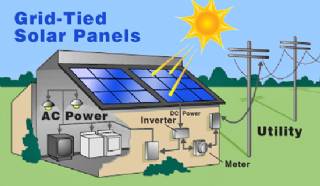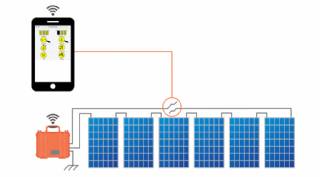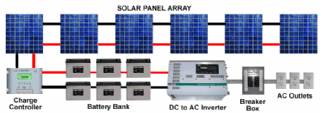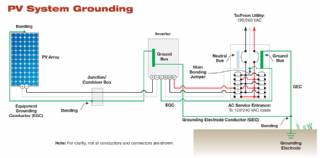Solar Energy Systems - Solar Modules - Solar Electric System Design - Solar Power

The heart of a photovoltaic system is the solar module. Many photovoltaic cells are wired together by the manufacturer to produce a solar module. When installed at a site, solar modules are wired together in series to form strings. Strings of modules are connected in parallel to form an array.
Module Types – Rigid flat framed modules are currently most common and most of these are composed of silicon. Silicon cells have atomic structures that are single-crystalline (a.k.a. mono-crystalline), poly-crystalline (a.k.a. multi-crystalline) or amorphous (a.k.a. thin film silicon). Other cell materials used in solar modules are cadmium telluride (CdTe, commonly pronounced “CadTel”) and copper indium diselenide (CIS). Some modules are manufactured using combinations of these materials. An example is a thin film of amorphous silicon deposited onto a substrate of single-crystalline silicon.
In 2005 approximately 90 percent of modules sold in the United States were composed of crystalline silicon, either single-crystalline or poly-crystalline. The market share of crystalline silicon is down from previous years, however, and continues to drop as sales of amorphous silicon, CdTe and CIS modules are growing.
Building Integrated Photovoltaic Products – PV technology has been integrated into roofing tiles, flexible roofing shingles, roofing membranes, adhesive laminates for metal standing-seam roofs, windows, and other building integrated photovoltaic (BIPV) products. BIPV modules are generally more expensive than rigid flat modules, but are anticipated to eventually reduce overall costs of a PV system because of their dual purpose.
Rated Power – Grid-connected residential PV systems use modules with rated power output ranging from 100-300 watts. Modules as small as 10 watts are used for other applications. Rated power is the maximum power the panel can produce with 1,000 watts of sunlight per square meter at a module temperature of 25oC or 77oF in still air. Actual conditions will rarely match rated conditions and so actual power output will almost always be less.
PV System Voltage – Modern systems without batteries are typically wired to provide from 235V to 600V. In battery-based systems, the trend is also toward use of higher array voltages, although many charge controllers still require lower voltages of 12V, 24V or 48V to match the voltage of the battery string.
Using Manufacturer’s Product Information to Compare Modules – Since module costs and efficiencies continue to change as technology and manufacturing methods improve, it is difficult to provide general recommendations that will be true into the future regarding, for example, which type of module is cheapest or the best overall choice. It is best to make comparisons based on current information provided by manufacturers, combined with the specific requirements of your application.
Module Cost per Watt – As a general rule, thin film modules have lower costs than crystalline silicon modules for modules of similar powers.
Module Efficiency (Watts per Area) – Modules with higher efficiency will have a higher ratio of watts to area. The higher the efficiency, the smaller the area (i.e. fewer modules) will be required to achieve the same power output of an array. Installation and racking 9 costs will be less with more efficient modules, but this must be weighed against the higher cost of the modules. Amorphous silicon, thin film CdTe and CIS modules have rated efficiencies that are lower than crystalline silicon modules, but improvements in efficiency continue.
Amorphous Silicon in Cloudy Climates – Of importance to the Pacific Northwest, amorphous silicon modules have higher efficiency than crystalline silicon under overcast conditions. In cloudy weather, all types of amorphous silicon modules tend to perform better than crystalline silicon, with multi-junction (i.e. double- and triple-junction) amorphous silicon modules performing as much as 15 percent better. In Britain, which has a similar climate to ours, multi-junction amorphous silicon modules have been shown to produce more power over the course of the year than crystalline silicon modules.
Poly-crystalline or Single-crystalline Silicon? – The power output of single-crystalline and poly-crystalline modules of the same area is quite similar.5 Both types of crystalline silicon are very durable and have stable power output over time. Therefore, do not be too concerned about the distinction between single-crystalline and poly-crystalline silicon in selecting a module.
Silicon Modules versus Other Module Types? – The power output of CdTe modules has been less stable than silicon modules,6 although improvements are being made. For the time being, as for modules of any type, check manufacturer’s warranties.
Labels
how tosolarcharge controllerbatterysolar panelspowerbatteriessolar panelsolar systemoff gridinverterpreparednessprepareddiy solarself reliancepreppermormonsystemsolar powerwarmingglobalenergyinstructionsalternativerenewableelectricitygreentechnologyhigh-techjapanesejapanrecycleself sufficientself reliantgenerationsustainableFarming Principle: Deep Soil Preparation
Looking at GB as a three-legged stool, deep soil preparation is one of the legs. Deep soil preparation builds soil and soil structure by loosening the soil to a depth of 24 inches (60 cm). Ideal soil structure has both pore space for air and water to move freely and soil particles that hold together nicely.

Smart Home Ecosystem - Smart Home Automation - Smart Home Security - Smart Home Technology
The outer-most level corresponds to the individual devices and sensors that consumers interact with. Several candidates are vying for the role of a leader introducing smart home services to the mass market.
Solar Energy Systems - Array Mounting Racks - Solar Ray - Solar Panel - PV Racks and Mounts
Arrays are most commonly mounted on roofs or on steel poles set in concrete. In certain applications, they may be mounted at ground level or on building walls. Solar modules can also be mounted to serve as part or all of a shade structure such as a patio cover. On roof-mounted systems, the PV array is typically mounted on fixed racks, parallel to t

Solar Energy Systems - Grounding Equipment
Grounding equipment provides a well-defined, low-resistance path from your system to the ground to protect your system from current surges from lightning strikes or equipment malfunctions. Grounding also stabilizes voltages and provides a common reference point. The grounding harness is usually located on the roof.

Solar Energy Systems - Solar Inverter - Solar Panel Inverter
Most grid-connected inverters can be installed outdoors, while most off-grid inverters are not weatherproof. There are essentially two types of grid-interactive inverters: those designed for use with batteries and those designed for a system without batteries.

Solar Energy Systems - Solar Disconnects
Automatic and manual safety disconnects protect the wiring and components from power surges and other equipment malfunctions. They also ensure the system can be safely shut down and system components can be removed for maintenance and repair.

Solar Energy Systems - Solar Battery Bank
Batteries store direct current electrical energy for later use. This energy storage comes at a cost, however, since batteries reduce the efficiency and output of the PV system, typically by about 10 percent for lead-acid batteries. Batteries also increase the complexity and cost of the system.

Solar Energy Systems - Solar Charge Controller
A charge controller, sometimes referred to as a photovoltaic controller or battery charger, is only necessary in systems with battery back-up. The primary function of a charge controller is to prevent overcharging of the batteries. Most also include a lowvoltage disconnect that prevents over-discharging batteries. In addition, charge controllers pr

Solar Energy Systems - The NEC and PV Systems
Solar PV systems must be installed in accordance with Article 690 of the National Electric Code, which specifically deals with PV systems, as well as several other articles of the NEC that pertain to electrical systems in general. When there is a conflict between NEC 690 and any other article, NEC 690 takes precedence due to the unique nature of PV

Ventilation Systems - Natural Ventilation
The bigger the both factors are the more intensive is the air change in rooms. This means that in colder weather conditions the rooms and the building is often over-ventilated and in warmer and windless weather, there is a lack of fresh air. As both of these factors are directly dependent on the external climate, the system is considered to be a no